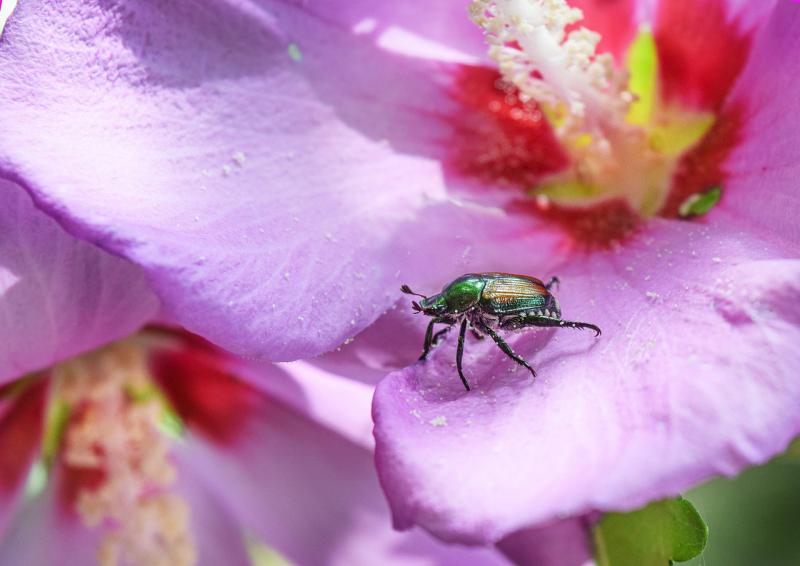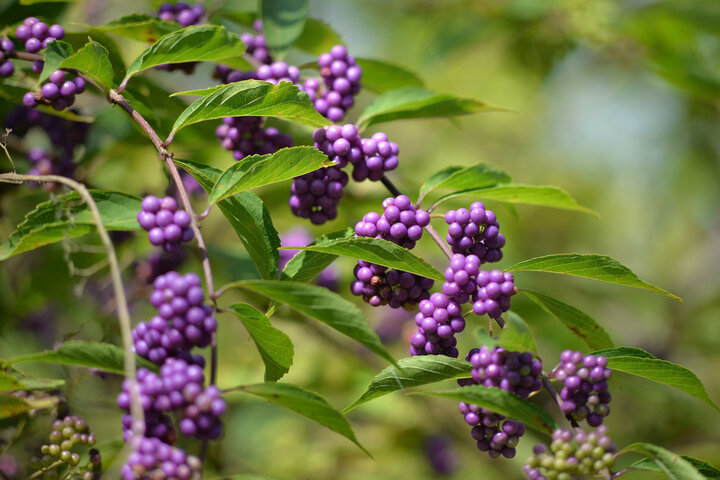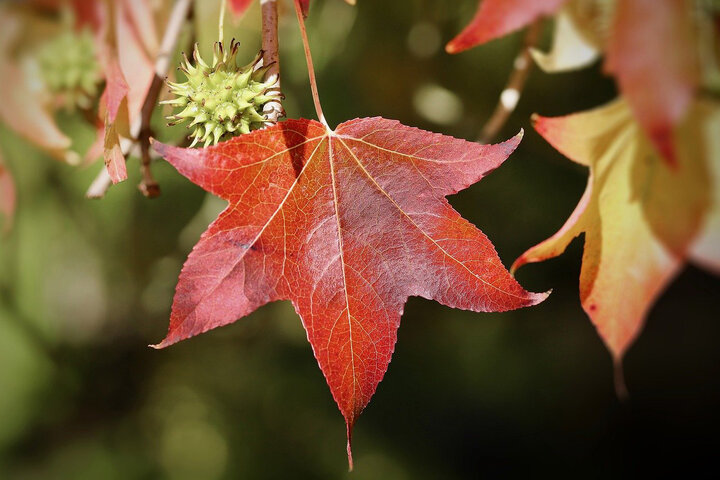Sarah Browning, Nebraska Extension Educator

Japanese beetles have definite plant preferences as food hosts, including hibiscus. Image from Pixabay
As if 2023 hasn’t thrown gardeners enough curves already - like drought damage in lawns, shrubs, trees and ornamentals – soon it will be Japanese beetle season. Wonderful, that’s all we need!
But we must be realistic and acknowledge the fact – Japanese beetles are here to stay. Once an invasive species like this one comes into an area, there is no good way to eliminate them completely. So, what can gardeners do - especially with an eye toward long-term damage reduction?
Eliminate Problem Plants
For a long-term solution to your headaches, get rid of the plants Japanese beetles love most. Swap them out for selections which are not preferred food sources. It's hard to give up some of our favorite plants, after all that's why they're in our landscapes in the first place, but there are good alternative worth considering.
It’s not necessary to eliminate every single plant susceptible to damage, but reducing their number will make insect management easier. Below is a list of common landscape plants which are the worst Japanese beetle magnets.
Fruits & vegetables – Apple & crabapple, basil, beans, brambles (raspberry, blackberry), cherry, currant, grape, peach, plum, strawberry, sweet corn silks
Ornamentals – Hibiscus, hollyhock, marigold, Rose of Sharon, Virginia creeper
Shrubs - Buttonbush, purpleleaf sandcherry (and most other ornamental or fruiting cherries), Peking cotoneaster, pussy willow, summersweet clethra, rose
Trees - American elm (and many other elm species), American mountain ash, black walnut, crabapple (below for more details), horsechestnut, linden (Greenspire and Olympic are among the worst), maple (Japanese, Norway), sycamore
Susceptibility to damage is quite variable amongst crabapple cultivars. Some have little to no damage, while others are severely damaged. Review "Relative Susceptibility of Woody Landscape Plants to Japanese Beetle" for a good listing of resistant and susceptible crabapple cultivars.

Plant for Resistance
So, what can be planted that Japanese beetles will leave alone? Never fear, there are many good choices which are not high on the preferred list for these pesky beetles. Below are plants which suffer from little to no feeding damage.
Fruits – common pear
Ornamentals – Ageratum, Begonia, Celosia, chrysanthemum, columbine, Coreopsis, Dianthus, daylily, geranium, Heuchera, Hydrangea (smooth, panicle), Lantana, lily, nasturtium, poppy, snapdragon, sweet pea, Veronica, wintercreeper Euonymus
Shrubs – Barberry, boxwood, burning bush, European cranberry bush viburnum, Forsythia, juniper, lilacs (common, Japanese tree, Persian), mockorange, privet, purple beautyberry, snowberry, spiraea, Weigela, winterberry holly, witch hazel, yew
Trees – American filbert, American sweetgum, crabapple, Douglas fir, Ginkgo, hickories (pignut, shagbark, butternut), Japanese pagoda tree, linden (Tilia americana), oaks (white, scarlet, red, black), red maple, redbud, spruce, tulip poplar

Develop Your Plan
Updating and replanting the landscape is a great long-term goal, but what can be done to minimize damage this year? Here are some quick tips.
- Don’t buy a trap.
- Plan to tolerate some damage. Healthy vigorous trees can tolerate a high level of damage with little to no long-term impact on its health. Small ornamental plants and small newly installed woody plants may need more protection.
- Prep your handpicking supplies – a bucket and dish soap. Scout for insects in the evening, around 7 p.m., and knock them into a bucket of soapy water.
- Choose an insecticide with low toxicity to bees and pollinators, such as neem or horticultural oil. Of course, additional higher toxicity products are also available but follow all label use directions to minimize their impact on beneficial insects and pollinators.
- If your lawn has a history of grub damage, apply a systemic product (Scott’s GrubEx, Merit, Mach II) from mid to late June.
Check out the publication below for more control recommendations, from noted entomologist Whitney Cranshaw, Colorado State University Extension.
Images from Pixabay.
- Purple beautyberry, Callicarpa dichotoma, is rarely damaged by beetles and makes a beautiful addition to a full sun or lightly shaded area.
- Sweetgum, Liquidambar styraciflua, is a great shade tree with beautiful fall color.
Search Our Archive
Associated Video
Japanese Beetle
Nebraska Extension Entomologist Jonathan Larson talks about controlling the Japanese Beetle.